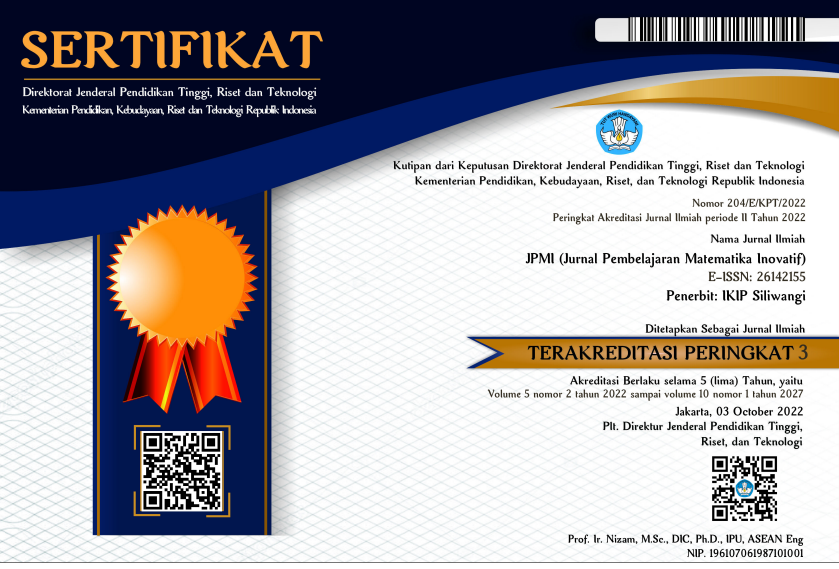Kemampuan komunikasi matematis siswa dikaji dari kemampuan spasial matematis di SMP
DOI:
https://doi.org/10.22460/jpmi.v7i2.18787Keywords:
Mathematical Communication Ability, Mathematical Spatial Ability, PolyhedronAbstract
This research illustrates that mathematical communication skills are considered the most needed abilities currently supported by other mathematical abilities, one of which is mathematical spatial abilities. This research aims to characterize the communication and mathematical visualization abilities of students at Nurul Islam Middle School, Sungai Kakap, Kubu Raya. Mixed methods, combining quantitative and qualitative techniques, were used in this research. Data was collected through interviews with 23 class VIII A students and analysis of their tests. The results show that the majority of students have moderate to low mathematical and spatial communication skills. Students' effective ability to convey understanding of mathematical concepts and mathematical spatial competence in flat shapes is among the lowest. This research reveals a relationship between strong mathematical communication skills and high spatial abilities, and vice versa.
References
Achdiyat, M., & Utomo, R. (2018). 2234-5756-1-Pb. Kecerdasan visual-spasial, kemampuan numerik, dan prestasi belajar matematika: Formatif: Jurnal Ilmiah Pendidikan MIPA,7(3), 234-245.
Bishop, J. P. (2012). “She’s always been the smart one. I’ve always been the dumb one”: Identities in the mathematics classroom. Journal for Research in Mathematics Education, 43(1), 34–74. https://doi.org/10.5951/jresematheduc.43.1.0034
Cheng, Y. L., & Mix, K. S. (2014). Spatial training improves children’s mathematics ability. Journal of Cognition and Development, 15(1), 2–11. https://doi.org/10.1080/15248372.2012.725186
Delgado, A. R., & Prieto, G. (2004). Cognitive mediators and sex-related differences in mathematics. Intelligence, 32(1), 25–32. https://doi.org/10.1016/S0160-2896(03)00061-8
Dianti, W., Zubaidah, & Hamdani. (2018). Kemampuan komunikasi matematis siswa dalam materi himpunan di kelas VII SMP Negeri 7 Kubu Raya. Jurnal Pendidikan Dan Pembelajaran Khatulistiwa, 7(7), 1–8.
Emzir. (2020). Metodologi penelitian pendidikan kuantitatif dan kualitatif. Rajawali Pers.
Fauzi, Muhammad Ulul. (2020). Analisis kemampuan komunikasi matematis siswa berdasarkan kecerdasan visual spasial. Repository Unmuhjember.
Gunur, B., Lanur, D. A., & Raga, P. (2019). Hubungan kemampuan numerik dan kemampuan spasial terhadap kemampuan komunikasi matematis siswa. Pythagoras: Jurnal Pendidikan Matematika, 14(2), 224–232. https://doi.org/10.21831/pg.v14i2.27250
Habsah, F. (2017). Developing teaching material based on realistic mathematics andoriented to the mathematical reasoning and mathematical communication. Jurnal Riset Pendidikan Matematika, 4(1), 43–55. https://doi.org/10.21831/jrpm.v4i1.10199
Lerman, S. (2014). Enclyclopedia of Mathematics Education. Spingers Reference. https://doi.org/10.17583/redimat.2015.1786
Lestari, karunia E., & Yudhanegara, M. R. (2015). Penelitian pendidikan matematika (2nd ed.). PT. Refika Aditama.
Linn, M. C., & Petersen, A. C. (1985). Emergence and characterization of sex differences in spatial ability: a meta-analysis. Child Development, 56(6), 1479–1498. https://doi.org/10.1111/j.1467-8624.1985.tb00213.x
Lubinski, D., & Benbow, C. P. (1992). Gender differences in abilities and preferences among the Gifted: Implications for the Math-Science Pipeline. Current Directions in Psychological Science, 1(2), 61–66. https://doi.org/10.1111/1467-8721.ep11509746
McLean, J. F., & Hitch, G. J. (1999). Working memory impairments in children with specific arithmetic learning difficulties. Journal of Experimental Child Psychology, 74(3), 240–260. https://doi.org/10.1006/jecp.1999.2516
Mullis, I. V. S., Martin, M. O., Foy, P., & Hooper, M. (2016). TIMSS 2015 International results in mathematics. Retrieved from Boston College, TIMSS & PIRLS International Study Center website: http://timssandpirls.bc.edu/timss2015/international-results/
National Academy of Science. (2006). Learning to think spatially. Washington DC: The National Academy Press.
NCTM. (2000). Principle and standards for school mathematics. : The National Council of Teachers of Mathematics, Inc.
OECD. (2019). PISA 2018 Assessment and analytical framework PISA. Paris: OECD Publishing.
Powell, S. R., & Hebert, M. (2016). Influence of writing ability and computation skill on influence of writing ability and computation skill on mathematics writing mathematics writing part of the special education and teaching commons. https://digitalcommons.unl.edu/specedfacpub
Robinson, N. M., Abbott, R. D., Berninger, V. W., & Busse, J. (1996). The structure of abilities in math-precocious young children: Gender similarities and differences. Journal of Educational Psychology, 88(2), 341–352. https://doi.org/10.1037/0022-0663.88.2.341
Rynhart, P. (2012). Importance of spatial skill. http://proactiveplay.com/importance-ofspatial-skills/
Small, M. (2013). Making math meaningful to Canadian students. Nelson education.
Soraya, W., Utami, C., & Nirawati, R. (2021). Analisis kemampuan spasial matematis siswa ditinjau dari teori bruner pada materi dimensi tiga. Jurnal Pendidikan Matematika Indonesia, 6(1), 19–23. https://doi.org/10.26737/jpmi.v6i1.2296
Wijayanto, A. D., Fajriah, S. N., & Anita, I. W. (2018). Analisis kemampuan komunikasi matematis siswa SMP pada materi segitiga dan segiempat. Journal Cendekia: Jurnal Pendidikan Matematika, 2(1), 97–104.
Downloads
Published
Issue
Section
License
Copyright (c) 2024 JPMI (Jurnal Pembelajaran Matematika Inovatif)

This work is licensed under a Creative Commons Attribution-ShareAlike 4.0 International License.
The author is responsible for acquiring the permission(s) to reproduce any copyrighted figures, tables, data, or text that are being used in the submitted paper. Authors should note that text quotations of more than 250 words from a published or copyrighted work will require grant of permission from the original publisher to reprint. The written permission letter(s) must be submitted together with the manuscript.
















